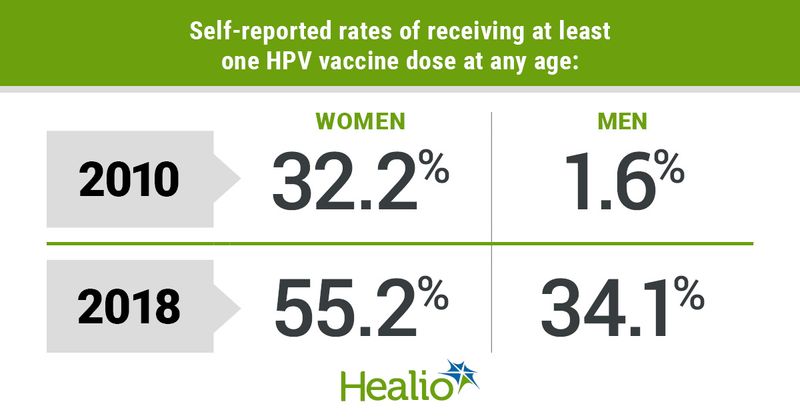Self-reported HPV vaccination rates ‘low,’ but increase over time
Self-reported HPV vaccination rates among young men and women aged 18 to 21 years were “low” but rose over time, researchers wrote.
Data also showed that overall HPV vaccination rates among men trailed behind women.

“HPV is the most common sexually transmitted infection in the United States and associated with several malignancies including oropharyngeal, cervical, vaginal, vulvar, penile and anal cancers,” Michelle M. Chen, MD, MHS, a clinical lecturer in the department of otolaryngology and head and neck surgery at the University of Michigan, told Healio Primary Care. “In 2020, the FDA expanded the indications for HPV vaccination to include the prevention of oropharyngeal cancer, which is the most common HPV-associated malignancy and about 80% of oropharyngeal cancer patients are male.”

Chen and colleagues analyzed unweighted data from 6,606 women and 6,038 men who participated in the National Health Interview Survey at some point from 2010 to 2018 to assess HPV vaccination rates and determine the differences in vaccination rates between the sexes.
The researchers reported in JAMA that after data weighting, 41.6% (95% CI, 40%-43.2%) of women and 16.2% (95% CI, 14.8%-17.7%) of men said they received at least one dose of HPV vaccine at any age. The vaccination receipt rate for the women rose from 32.2% (95% CI, 27.9%-36.7%) in 2010 to 55.2% (95% CI, 49.4%-60.9%) in 2018 (P = .001). For men, this rate rose from 1.6% (95% CI, 0.6%-4.1%) to 34.1% (95% CI, 28.5%-40%) during the same time span (P < .001).
In addition, among all the women in the study, 3.8% (95% CI, 3.4%-4.3%) received their first HPV vaccine dose while aged 18 to 21 years; among all the men, 2.7% (95% CI, 2.3%-3.1%) received their first dose while aged 18 to 21 years. A total of 46.3% (95% CI, 37.6%-55.2%) of these women and 29.1% (95% CI, 20.4%-39.7%) of these men received the entire three-dose vaccination series.
“In recent years, the vaccination rates for adolescent boys have increased to be close to the rate for adolescent girls,” Chen said. “However, overall vaccination rates still lag for men and we could be doing a better job of providing the catch-up vaccination to men.”
Chen and colleagues suggested several ways to increase vaccine uptake among young adults, such as ascertaining HPV vaccination status when providing the influenza vaccine and removing cost barriers. To improve HPV vaccination rates in men, the researchers recommended leveraging university or community vaccination campaigns and providing adult primary care clinicians with information regarding the risk for HPV-associated cancers.


